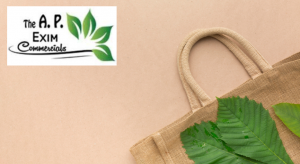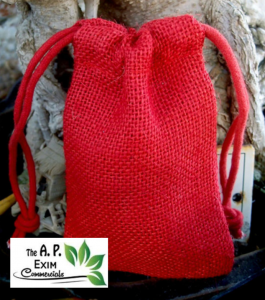The use of jute bags dates back hundreds of years, and consumers who care about the environment still frequently choose them. The history and evolution of jute bags are a tale of creativity, sustainability, and classic style.

The history and evolution of jute bags
In this blog post, We’ll evaluate the intriguing development of jute bags across time as well as its lasting appeal as a resource-efficient and adaptable accessory.
What are Jute Bags?
Jute bags are manufactured from the jute plant’s fibers and are environmentally friendly bags. Jute is an environmentally friendly substitute for commodities like cotton or synthetic fibers since it grows quickly and uses little water and pesticides. Due to its strength, reusability, and ability to break down naturally, jute bags are a preferred option among those who care about the environment.
Jute Bags: A Brief History
The history and evolution of jute bags that shows how resourceful people have been in developing eco-friendly substitutes for common household items. From ancient times, when people used them to store food and other goods, jute bags have been in use.
For thousands of years, jute has been used to make textiles and other items. Jute was utilized by the ancient Egyptians to manufacture ropes and paper, as well as textiles by the Chinese and Indians. In India around the 17th century, jute bags as we know them now were initially used to transport items including tea, coffee, and spices.
Plants of the jute kind are mostly grown in Bangladesh and India. From ancient times, its fibers have been used to make textiles, ropes, and other products. Jute didn’t start to be used extensively for bags until the 19th century. Coffee and sugar were among the first items transported in jute bags. They were solid and durable, making them a perfect alternative for delivering big things. Jute manufacture developed into a prominent sector across the world as demand for jute bags increased.
Who invented jute?
Early in the 17th century, the Dutch and the French discovered jute. As you can imagine, they were thrilled about this resilient plant fiber, knowing it could take care of all their basic needs and more. So they transported it from Bengal to Europe. The British East India Company did the same later, to Britain.
Who invented jute bag?
Bangladeshi scientist Dr. Mubarak Ahmad Khan who has been researching since 1990 to make and use Jute’s business uses and potential outcomes invented a biodegradable and eco-friendly bag from jute cellulose, which is being considered to have great potential in replacing plastic bags.
The Industrial Revolution and the Emergence of Jute Bags
Jute bags have grown in popularity recently as people look for sustainable and eco-friendly alternatives to standard bags. As new manufacturing techniques were developed during the Industrial Revolution, it became possible to manufacture jute bags on a big scale, which is when The history and evolution of jute bags began.
The techniques and processes developed during the Industrial Revolution simplified and reduced the cost of producing jute bags. Jute bags became more and more in demand as they started to be used often for storing and carrying commodities like coffee, sugar, and other things. Yet more than simply practicality was responsible for the popularity of jute bags.
Moreover, jute bags were viewed as a representation of development and modernization. They sprang from the Industrial Revolution, a time when efficiency and invention were highly regarded.
The rise of the Industrial Revolution is strongly related to The history and evolution of jute bags. Jute bags were a result of new manufacturing techniques and technology that allowed for their mass production. Yet they were also a representation of development and modernity, reflecting the standards of the day. Those who value sustainability and elegance continue to often choose jute bags nowadays.
‘Eco-Friendly Lifestyle, Buy A Jute Bag’
Throughout the Modern Period, Jute Bags
Growing environmental awareness and a preference for sustainable goods are reflected throughout The history and evolution of jute bags. Jute bags are now a chic, environmentally beneficial item that inspires a desire for ethical consumerism and pleasant feelings of concern for the environment.
In the present day, jute bags have grown in popularity as people look for sustainable and eco-friendly alternatives to standard bags. In contrast to nonrenewable materials like plastic, jute is a sustainable crop that can be grown with low water and pesticide use.

Jute bags are adaptable and fashionable, available in a variety of patterns and sizes to fit every need. They may be utilized as fashionable accessories for any outfit, for transporting books to work or school, or for supermarket shopping.
The growing popularity of jute bags demonstrates a change in consumer ideals towards sustainability & responsible purchasing. Customers who prefer jute bags over regular bags may appear chic and current while also having a good influence on the environment.
The Rising Significance of Jute Bags
The history and evolution of jute bags have been an interesting one, so it’s no surprise that they’ve grown to be so well-liked in modern society. Because more people are becoming aware of the effects of plastic bags on the environment, jute bags have become quite popular. These are some explanations for why jute bags are popular right now:
- Environmentally Friendly: Jute bags are a great eco-friendly substitute for plastic bags since they are created from natural fibers that are biodegradable, recyclable, and renewable.
- Stylish and Versatile: Jute bags are a stylish accessory that go with every outfit since they are available in a wide range of hues and patterns. They are ideal for carrying large goods like books, groceries, or computers since they are sturdy and long-lasting.
- Affordable and Accessible: Both people and companies may readily access jute bags, which are a budget-friendly solution. These are a popular option for promotional gifts or freebies since they can be personalized with logos or designs.
- Sustainable Option: Jute is an environmentally friendly fiber that may be used to make a variety of items, including bags. It grows quickly and needs little water and fertilizer.
Carrying a jute bag gives us the impression that we are having a beneficial influence on the earth. They have become a symbol of responsible living. The history of jute bags, from their modest origins as utilitarian sacks to their current standing as a fashion statement, is one that gives us pride and hope for a brighter future.

What is the history of jute craft?
Eastern India has been the center of development for the jute industry in India. The Medieval Ages saw Bengal produce the most jute in the world, which was used to make sacks and saris. Jute sacks were first exported as a need in the 18th century.
Which state is famous for jute handicrafts?
Assam, West Bengal, and Bihar are the states that produce the majority of the world’s jute.
Jute Bags in the Future
The history and evolution of jute bags are a tale of sustainability, longevity, and fashion. The future of jute bags is bright given the growing awareness of environmental problems and the harm caused by plastic bags. Jute bags have a promising future as more people adopt sustainability and environmental friendliness into their daily lives. The following are some important aspects about the future of jute bags:
- Increasing demand: The demand for environmentally friendly goods like jute bags is anticipated to increase as people become more aware of how their decisions affect the environment. Future predictions indicate that this tendency will persist.
- Innovation in design: In addition to being eco-friendly, jute bags are both functional and fashionable. Future jute bag designs and styles should incorporate more avant-garde elements to suit a wider range of tastes.
- Business opportunities: Businesses have a fantastic chance to take advantage of the growing industry and provide eco-friendly alternatives to conventional plastic bags by capitalizing on the demand for jute bags. Also, this can assist firms in enhancing their sustainable credentials.
- Government initiatives: The usage of jute bags and other environmentally friendly alternatives is being encouraged by governments all over the world. Future demand for jute bags is probably going to increase as a result of this.
- Global reach: Jute is a sustainable and renewable resource that may be used by several businesses and consumers internationally since it is grown in numerous nations all over the world. This indicates that jute bags have the potential to replace plastic bags as a well-liked and widely-used alternative globally.
‘You hold the power to choose the Earth’s future, so Use Jute Bags & Refuse plastic bags!’
Conclusion
It is obvious that The history and evolution of jute bags are intriguing, with tales of sustainability, toughness, and design. Jute bags have come a long way from their modest origins as sacks for carrying things to their current status as stylish and environmentally beneficial accessories. It’s encouraging to see that jute bags are becoming more and more popular nowadays, as more and more individuals are motivated by a desire to preserve the environment and have a beneficial influence. By using jute bags, we can all contribute in modest but meaningful ways to protecting the environment for future generations while also enjoying a fashionable and useful item.
Hopefully, the above explanation about The history and evolution of jute bags will help you when you are interested in knowing more about jute bags.
So, if you’re looking for affordable and excellent Jute bags for You that look fashionable and stylish then your search ends here. This is the right place for you because The A. P. Exim Commercials is the Best Jute Bag Manufacturer in India.
A. P. Exim Commercials provides you the Best Jute bags or Cotton Bags.
Get more information then touch with us.
The A. P. Exim Commercials, has been a major manufacturer and exporter of all kinds of Eco Friendly fabric bags namely JUTE , COTTON , JUCO , PAPER In recent years, the company restructured its business portfolios to focus on a wide range of eco friendly branding products and Packaging solutions.
Address: Sukanta Nagar 3rd Sarani, Post- Michael Nagar, Behind Mothers Nursing Home, Kolkata – 700133 New Barrakpur, West Bengal, India.
Email : info@apcommercials.com
Contact no: 9051575726

